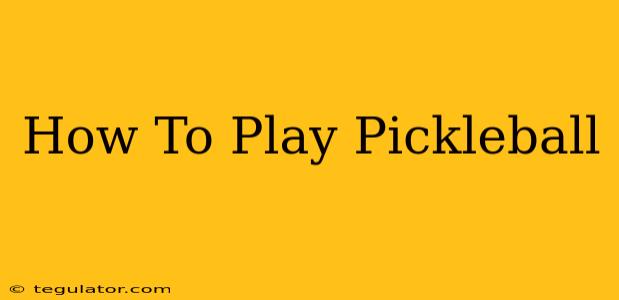Pickleball is taking the world by storm! This fast-paced paddle sport combines elements of tennis, badminton, and ping-pong, making it accessible and enjoyable for players of all ages and skill levels. Whether you're looking for a fun new hobby or a competitive challenge, this guide will walk you through the basics of how to play pickleball.
Understanding the Court and Equipment
Before you even think about hitting the ball, let's familiarize ourselves with the game's setting and essentials:
The Pickleball Court
A pickleball court is smaller than a tennis court, measuring 20 feet wide and 44 feet long for doubles, and 20 feet wide and 34 feet long for singles. A 7-foot "non-volley zone" (also known as the "kitchen") extends from the net on each side. This zone plays a crucial role in gameplay, as we'll see later.
Essential Equipment
- Paddles: Pickleball paddles are smaller than tennis rackets, typically made from wood, graphite, or composite materials. Choosing the right paddle depends on your playing style and preferences.
- Balls: Pickleball balls are perforated plastic balls, slightly larger than ping-pong balls and less bouncy than tennis balls.
- Net: The net is lower than a tennis net, hanging at 36 inches at the center.
The Basics of Gameplay: Serving and Scoring
The game begins with a serve, which must be underhand and below the navel. The server must stand behind the baseline. The serve must land diagonally into the opponent's service box.
Scoring:
Points are only scored by the serving team. Games are typically played to 11 points, with a two-point advantage needed to win. After each point, the server rotates. Double faults result in a side-out (the other team gains the serve).
Key Rules and Strategies
- The Non-Volley Zone (Kitchen): You cannot volley (hit the ball in the air before it bounces) while standing in the kitchen. You can only volley the ball after it bounces. Entering the kitchen to hit a ball that has already bounced is perfectly legal.
- The Double Bounce Rule: In doubles play, the ball must bounce once on each side of the net before volleys are allowed. In singles, this rule does not apply.
- Faults: Faults include hitting the ball out of bounds, hitting the net during the serve, failing to serve correctly (underhand and below the navel), and volleys in the kitchen.
Mastering the Shots: Developing Your Pickleball Game
As your skills develop, you'll want to expand your shot repertoire beyond basic serves and returns. Here are a few key shots to work on:
- The Dinking Shot: A soft, controlled drop shot played near the net. This is a crucial shot for controlling the point.
- The Drive: A powerful, aggressive shot played with more force.
- The Volley: A shot hit in the air before the ball bounces. (Remember the kitchen rules!)
Finding a Game and Improving Your Skills
Ready to get started? Finding a local pickleball club or community group is a great way to meet other players and improve your skills. Many parks and recreation centers offer pickleball courts and lessons. Watching professional pickleball can also help you understand game strategy and shot techniques.
Conclusion: Enjoy the Game!
Pickleball is a dynamic and social sport that offers a fantastic workout while providing hours of fun. Don't be afraid to get out there, try it, and enjoy the friendly competition. Remember to practice, have fun, and most importantly, be a good sport!

